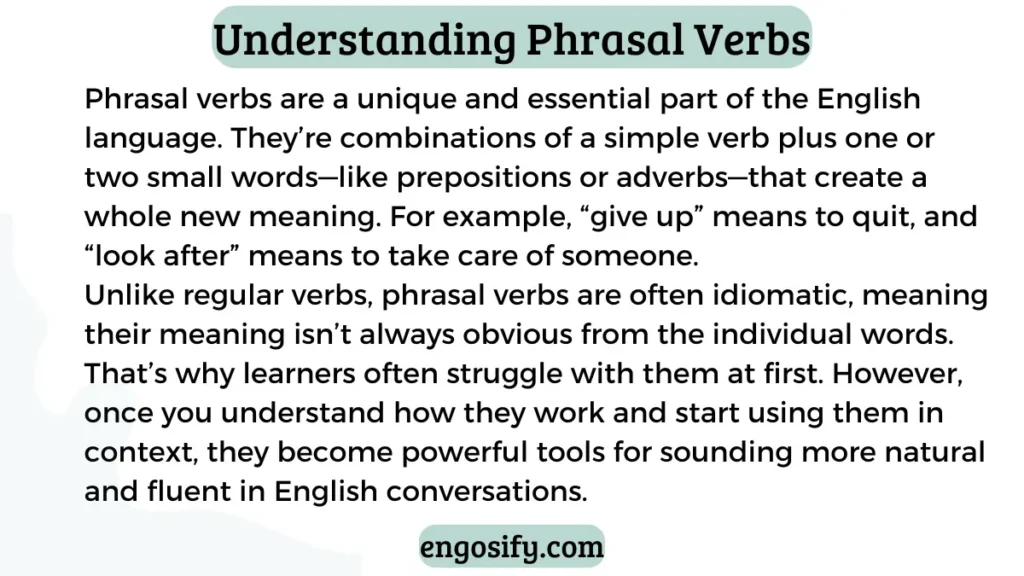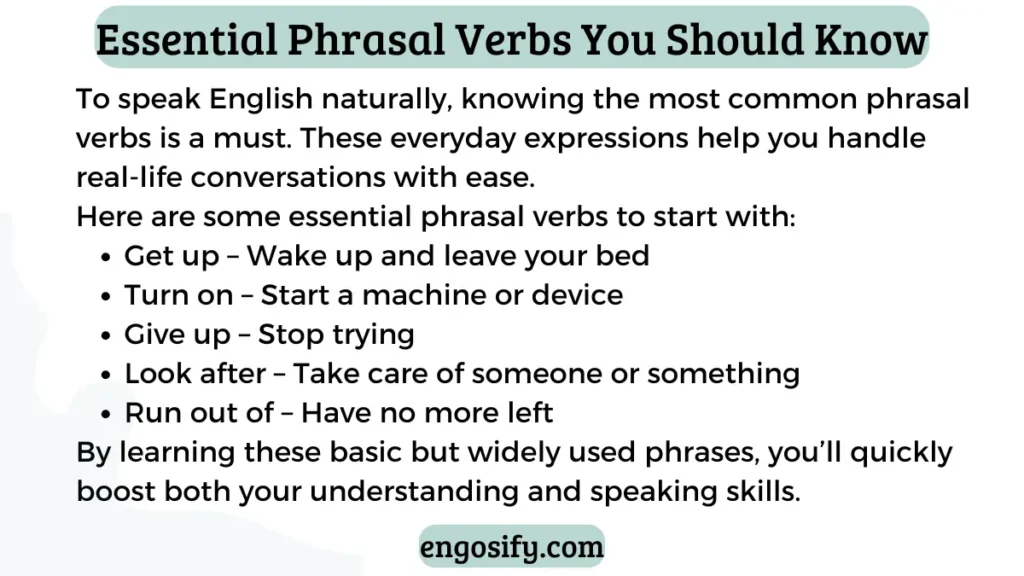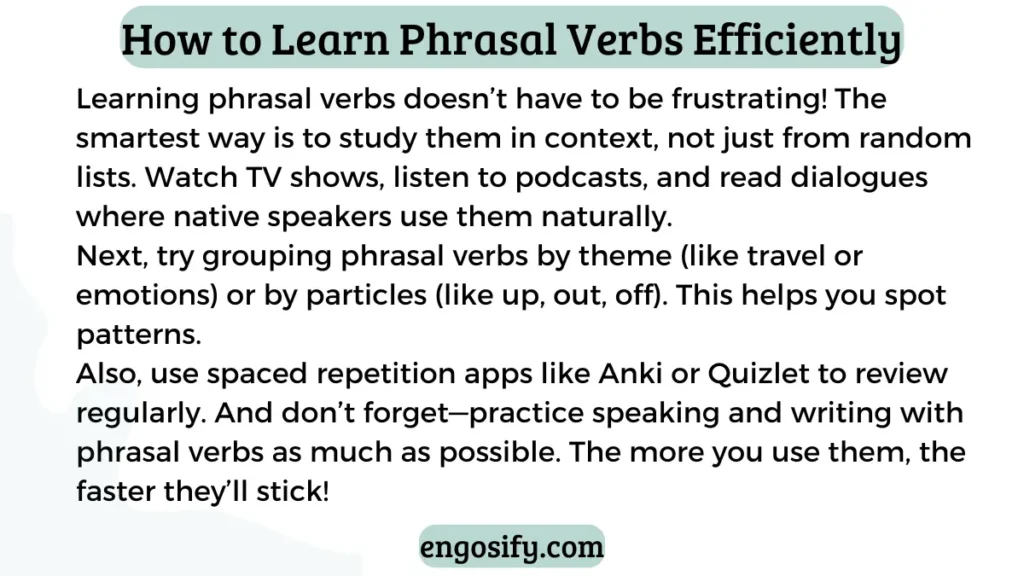Learning phrasal verbs can feel like learning a whole new language within English! These small but mighty verb phrases are everywhere in daily conversations. From movies and TV shows to casual chats with friends, native speakers use phrasal verbs constantly—sometimes without even realizing it.
But for English learners, mastering phrasal verbs can be a big headache. Why? Because their meanings are often idiomatic, and they don’t always make sense when you try to translate them word-for-word.
In this article, we’re going to break things down in a simple, fun, and engaging way. You’ll discover:
- What phrasal verbs really are
- Why they’re tricky but super important
- Essential examples you need to know
- Smart strategies for learning and remembering them
- And answers to your top questions about phrasal verbs
So, if you’re ready to boost your vocabulary and sound more like a native speaker, let’s dive in!
Understanding Phrasal Verbs
What Is a Phrasal Verb?
At its core, a phrasal verb is a combination of a verb and one (or sometimes two) small words called particles. These particles can be prepositions (on, in, over) or adverbs (up, down, out). Together, they create a meaning that’s often different from the original verb.
For example:
- “Give up” doesn’t mean to physically hand something upward. It means to quit.
- “Look after” doesn’t mean to stare at something that’s behind you. It means to take care of someone or something.
This mix of simple words plus hidden meaning is what makes phrasal verbs tricky but fun once you get the hang of them!
Why Phrasal Verbs Confuse Learners
It’s no secret—phrasal verbs confuse most English learners for a few reasons:
- Multiple Meanings:
Some phrasal verbs like “get on” can mean different things based on context. It could mean to board a bus or to get along with someone. - Separable and Inseparable Forms:
Certain phrasal verbs let you put the object in the middle (e.g., “turn the light off” vs. “turn off the light”), while others don’t allow it at all. - No Direct Translation:
Many phrasal verbs don’t exist in other languages or have a direct match, making them harder to learn through word-for-word translation. - Idiomatic Usage:
Phrasal verbs often carry figurative meanings. Take “break up”—it has nothing to do with physically breaking something, but rather ending a relationship.
But here’s the good news: With the right approach and practice, you’ll soon find that phrasal verbs aren’t your enemy—they’re your secret weapon for sounding more natural in English.

The Power of Phrasal Verbs in Everyday Speech
If you’ve ever listened to a conversation between native English speakers, you’ve probably noticed just how often phrasal verbs pop up. From friendly chats to business meetings, they’re everywhere! But why do native speakers love using them so much? Let’s break it down.
Natural, Casual Language
First and foremost, phrasal verbs make English sound casual and conversational. Instead of saying “cancel,” native speakers say “call off.” Instead of “arrive,” they’ll say “turn up.”
Using phrasal verbs makes your speech feel lighter and more natural. It’s like choosing to walk in sneakers instead of formal shoes—it just fits better in everyday situations.
For example:
- Instead of: “We need to cancel the meeting.”
- A native speaker would say: “We need to call off the meeting.”
Or:
- Instead of: “Please enter the room.”
- They’d say: “Come in.”
These small changes make a big difference in how approachable and fluent you sound.
Nuance and Efficiency
Another reason phrasal verbs are so popular is that they often express complex ideas with just a couple of words. They carry nuances of mood, tone, and attitude that single verbs don’t always capture.
For instance:
- “Give up” conveys the feeling of defeat or surrender, which is more emotionally loaded than simply saying “quit.”
- “Run into someone” suggests a casual, unplanned meeting, while “meet” sounds more formal or scheduled.
This flexibility makes phrasal verbs incredibly useful in expressing feelings, actions, and situations with color and personality.
Moreover, many phrasal verbs have become cultural staples in English-speaking countries, showing up in movies, TV shows, music, and even advertising.
So, if you really want to speak English like a native, mastering phrasal verbs is non-negotiable!
50 Essential Phrasal Verbs You Should Know
Ready to supercharge your vocabulary? Let’s dive into some of the most common and useful phrasal verbs that will help you sound more like a native speaker in no time! We’ll break them into everyday themes to make them easier to remember and use.
Daily Life Phrasal Verbs
- Get up – to rise from bed
- Turn off – to stop something from working (e.g., lights, devices)
- Put on – to dress or wear something
- Take off – to remove something you’re wearing
- Look after – to care for someone or something
- Wake up – to stop sleeping
- Go out – to leave home for social activities
- Come back – to return
- Run out (of something) – to use all of something
- Clean up – to tidy or organize a space
Work & Study Phrasal Verbs
- Carry out – to complete a task
- Fill in – to complete information (e.g., forms)
- Figure out – to solve or understand something
- Hand in – to submit work
- Catch up (on something) – to reach the same level as others
- Look into – to investigate
- Put off – to postpone
- Take on – to accept responsibility
- Work out – to find a solution
- Go over – to review something
Travel & Directions Phrasal Verbs
- Set off – to start a journey
- Check in – to register (at a hotel or airport)
- Get on – to board (bus, train, plane)
- Get off – to leave (bus, train, plane)
- Pick up – to collect someone or something
- Drop off – to leave someone or something at a place
- Take off – when a plane leaves the ground
- Look around – to explore a place
- Hold up – to delay
- Head out – to leave or start moving
Social & Relationships Phrasal Verbs
- Ask out – to invite someone on a date
- Break up – to end a relationship
- Get along (with someone) – to have a good relationship
- Make up – to forgive and become friends again
- Hang out – to spend time casually
- Cheer up – to become happier
- Call back – to return a phone call
- Look forward to – to anticipate something with excitement
- Show up – to appear or arrive
- Back out – to withdraw from an agreement

Emotions & Reactions Phrasal Verbs
- Calm down – to relax after being upset
- Give up – to stop trying
- Blow up – to suddenly become angry
- Break down – to become emotionally upset
- Chill out – to relax
- Freak out – to become very upset or excited
- Hold back – to restrain emotions
- Light up – to suddenly become happy
- Pull through – to recover from something difficult
- Turn down – to refuse an offer
How to Learn Phrasal Verbs Efficiently
Let’s be real—memorizing endless lists of phrasal verbs can feel like a chore. But guess what? It doesn’t have to be! With the right strategies, you can make learning these tricky little phrases fun, effective, and long-lasting. Let’s explore how.
Learn in Context, Not Just Lists
Sure, lists are handy for quick reference, but if you want to actually remember and use phrasal verbs, you need to learn them in real-life situations.
For example:
- Instead of just memorizing “give up”, read or listen to sentences like:
“I wanted to quit the race, but I didn’t give up.”
By seeing or hearing phrasal verbs in action, your brain connects them to meaning and usage. Try reading English short stories, watching YouTube interviews, or listening to podcasts. The British Council guide to phrasal verbs offers great reading materials for this!
Organize by Particle or Theme
Another smart move? Group phrasal verbs either by the particles they use (up, out, off, etc.) or by themes like work, travel, and emotions.
For example:
- “Break up, cheer up, give up” – All end with up and relate to change or emotional states.
- Or group them like “travel phrasal verbs” (check in, take off, set out).
This method makes it easier to notice patterns and memorize faster.

Use Spaced Repetition Tools
Apps like Anki, Quizlet, or Memrise use spaced repetition, a learning method proven to help your brain retain new vocabulary long-term.
Make your own digital flashcards for each phrasal verb. Include the definition, an example sentence, and even a small image if possible. Reviewing regularly will lock them into your memory.
Practice with Media & Shadowing
Expose yourself to authentic English content like TV shows, YouTube videos, and podcasts that feature natural conversations. Pay attention to how native speakers use phrasal verbs.
One powerful technique is shadowing—listen to a short sentence, then repeat it immediately, copying the tone and rhythm. For example:
- Watch a scene from Friends, pause after hearing a phrasal verb like “hang out”, and repeat:
“Do you want to hang out later?”
The article from Fluent in 3 Months offers more on learning phrasal verbs naturally through listening.
Speak and Write with Phrasal Verbs
Lastly, don’t forget to use what you learn! Challenge yourself to write a short diary entry using five new phrasal verbs. Or slip them into your next conversation with a language partner.
The more you use phrasal verbs, the more they’ll stick. And soon enough, you’ll start sounding more and more like a native speaker!
Handling Learning Roadblocks
Let’s face it—learning phrasal verbs isn’t always smooth sailing. Even advanced English learners sometimes stumble over them. But don’t worry! With the right mindset and tools, you can overcome these common challenges and make real progress.
Too Many Phrasal Verbs to Remember? Start Small!
One of the biggest complaints from learners is, “There are just too many phrasal verbs! How can I remember them all?”
Here’s the trick: Focus on the top 50 to 100 most common phrasal verbs first. These cover most everyday conversations. As you become more confident, slowly expand your list.
For example, begin with verbs like:
“get up,” “turn on,” “look for,” and “give up.”
You don’t need to learn them all at once—quality beats quantity every time.
Struggling with Separable and Inseparable Forms? Learn the Rules
Another headache? Knowing when you can separate the verb and particle. Some phrasal verbs are separable, while others are inseparable.
- Separable Example:
You can say:
“Turn off the lights” or “Turn the lights off.” - Inseparable Example:
You must say:
“Look after the kids” (Never: ✖️ “Look the kids after”)
A great resource for this is the NativeSpeakers phrasal verbs guide where separable and inseparable phrasal verbs are explained with examples.
Getting Confused by Idiomatic Meanings? Context is Key
Sometimes, learners get frustrated because phrasal verbs often don’t make logical sense. The solution? Stop trying to translate literally.
Instead, focus on how each verb is used in real conversations, TV shows, books, or podcasts. Surround yourself with English! The meaning will start to click naturally over time.
For example:
- Instead of wondering why “give up” means “quit”, just notice how native speakers use it and copy the usage.
Afraid You’ll Forget Them? Review Regularly
The truth is, it’s normal to forget new vocabulary—unless you review and use it consistently.
Build a habit of reviewing 5 to 10 phrasal verbs each week. Create simple example sentences and repeat them aloud.
Apps like Quizlet or even simple paper flashcards work wonders when used daily.
Remember: Learning phrasal verbs is like building muscle. The more you train, the stronger you get!
FAQs
What’s the Difference Between a Phrasal Verb and a Prepositional Phrase?
Great question! A phrasal verb combines a verb and one or more particles (like a preposition or adverb) to create a new, idiomatic meaning.
For example:
- Phrasal Verb: “Look after” (meaning: take care of)
- Prepositional Phrase: “Look at the painting” (meaning: direct your eyes towards something)
The key difference? Phrasal verbs change the original meaning of the verb, while prepositional phrases just add more detail to the action.
How Can I Use Phrasal Verbs Naturally in Conversations?
The secret is exposure and practice. Don’t just memorize definitions—listen to native speakers, watch movies, and read dialogues where phrasal verbs appear naturally.
Also, try shadowing exercises:
- Listen to a sentence with a phrasal verb
- Pause
- Repeat the full sentence out loud
Over time, you’ll build the instinct to use phrasal verbs automatically in conversation.
Are There Formal Alternatives to Phrasal Verbs?
Absolutely! While phrasal verbs are common in spoken and informal English, there are often more formal, one-word alternatives used in writing or professional settings.
For example:
- “Put off” = “Postpone”
- “Find out” = “Discover”
- “Call off” = “Cancel”
However, in casual conversations, sticking with phrasal verbs will help you sound more natural and fluent.
Why Do Native Speakers Use So Many Phrasal Verbs?
Simply put, phrasal verbs are short, expressive, and efficient. They help people say more with fewer words, and they often carry emotional or cultural meaning that single-word verbs lack.
By learning them, you’re not just learning grammar—you’re unlocking the heart of real, everyday English communication.
What’s the Fastest Way to Learn and Remember Phrasal Verbs?
Here’s a quick success formula:
- Learn in context (watch shows, read, listen)
- Group by theme or particle
- Use flashcards with spaced repetition
- Practice speaking and writing with them
- Review regularly and track your progress
Conclusion
Mastering phrasal verbs may seem like climbing a steep hill at first, but trust me, it’s one of the most rewarding steps in your English learning journey. These everyday expressions are the secret sauce that makes native speakers sound casual, clear, and relatable.
By focusing on learning in context, practicing regularly, and engaging with real English media, you’ll soon notice phrasal verbs slipping naturally into your speech and writing. Don’t stress about memorizing hundreds at once. Start small, stay consistent, and celebrate every time you confidently use one in a sentence.
With time, patience, and the strategies we’ve covered, you’ll sound more like a native speaker and feel more connected to the English-speaking world. So go ahead—pick a few new phrasal verbs today and start using them right away!

